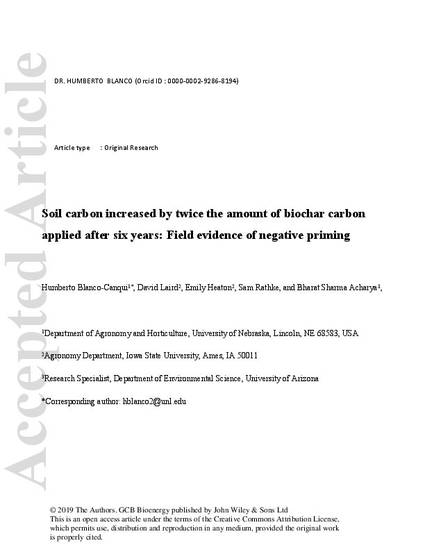
Applying biochar to agricultural soils has been proposed as a means of sequestering carbon (C) while simultaneously enhancing soil health and agricultural sustainability. However, our understanding of the long‐term effects of biochar and annual versus perennial cropping systems and their interactions on soil properties under field conditions is limited. We quantified changes in soil C concentration and stocks, and other soil properties 6 years after biochar applications to corn (Zea mays L.) and dedicated bioenergy crops on a Midwestern US soil. Treatments were as follows: no‐till continuous corn, Liberty switchgrass (Panicum virgatum L.), and low‐diversity prairie grasses, 45% big bluestem (Andropogon gerardii), 45% Indiangrass (Sorghastrum nutans), and 10% sideoats grama (Bouteloua curtipendula), as main plots, and wood biochar (9.3 Mg/ha with 63% total C) and no biochar applications as subplots. Biochar‐amended plots accumulated more C (14.07 Mg soil C/ha vs. 2.25 Mg soil C/ha) than non‐biochar‐amended plots in the 0–30 cm soil depth but other soil properties were not significantly affected by the biochar amendments. The total increase in C stocks in the biochar‐amended plots was nearly twice (14.07 Mg soil C/ha) the amount of C added with biochar 6 years earlier (7.25 Mg biochar C/ha), suggesting a negative priming effect of biochar on formation and/or mineralization of native soil organic C. Dedicated bioenergy crops increased soil C concentration by 79% and improved both aggregation and plant available water in the 0–5 cm soil depth. Biochar did not interact with the cropping systems. Overall, biochar has the potential to increase soil C stocks both directly and through negative priming, but, in this study, it had limited effects on other soil properties after 6 years.
Available at: http://works.bepress.com/emily-heaton/64/

This article is published as Blanco-Canqui H, Laird DA, Heaton EA, Rathke S, Acharya BS. Soil carbon increased by twice the amount of biochar carbon applied after 6 years: Field evidence of negative priming. GCB Bioenergy. 2020;12:240–251. doi: 10.1111/gcbb.12665.